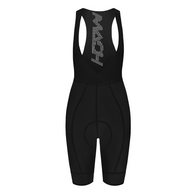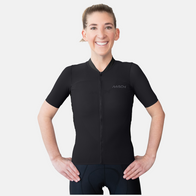
Essential Gear for the New Triathlete
Bikes and wetsuits and nutrition - oh my!
Between 2006 and 2017, participation in triathlon across the United States grew from under one million to over four million. With it has come multitudes of different gear - from the most aerodynamic bikes to the tightest aero triathlon suits - which can be a tad hard to wade through as a new triathlete.
The Mach team has come together to compile our list of the top ten essential pieces of gear for the beginner triathlete, listed in descending order of importance. We will also link to some of our favorite (and most affordable) brands of gear - because we know triathlon can get expensive.
Bike
This one seems pretty straightforward, we know. But from the outside looking in, it’s easy to assume that you need the latest and greatest time trial bike to participate in triathlon. That is so far from the truth. Most of us here at Mach finished our first triathlons on a cheap road bike, and that means you can do the same! Make an investment in a bike that you like and are comfortable on, that is the most important. Upgrades can always come later!
Helmet
Don’t make this one complicated. Yes, aero helmets are cool and spending $500 on a slick, teardrop-shaped helmet so you can look like the pros is definitely appealing. But, save the extra pennies and get a solid road helmet to start. They are much cheaper, equally as safe and are much more fun to train in than an aero helmet (hello crappy ventilation!).
Check out some of our favorite road helmets from Bontrager and Specialized.
Running Shoes
This one seems almost as obvious as the last few. Our biggest recommendation when buying running shoes is to go to your local running store and have them fit you for the proper shoe shape and size. With the amount of time you’ll be spending in these puppies, you want to be sure they are the best shoe for YOU specifically. And don’t skimp here - buy the shoe that is the most comfortable, regardless of the price tag.
Triathlon Suit
This is the outfit you will spend your entire race in, and there are two primary differences you need to consider when choosing one for yourself - one-piece or two-piece, and with or without sleeves. Triathlon suits are built to be comfortable and stay put for each of the three disciplines and will do so whether you choose a full suit with sleeves or a two-piece without. Two pieces are often worn at the longer distances as they provide easier access for bathroom stops, while one pieces are worn at both the short and long distances due to the fact they often stay in place better.
Check out our eco-friendly and antimicrobial two-piece aero kits and full aero suits.
Goggles + Swim Cap
Probably two of the cheapest items you will buy during your triathlon racing career, goggles and swim caps are essential items for your training journey. Latex caps often stay on the head better, while silicon caps are a bit softer and prevent any hair pulling. And with goggles, it is important they fit your face appropriately to provide any leaking during training or racing. Another thing to consider is purchasing mirrored goggles - they will help deflect sunlight and improve visibility in direct sunlight.
Sunglasses
Do you want to be squinting all day…? We didn’t think so. Whether you buy them at Target or get a sleek pair of Smith or Rudy glasses, just make sure they are comfortable and stay put while you are running. Not much more to consider than that!
Wetsuit
Most triathletes will invest in a good wetsuit within the first two years of their racing career. While they may not be necessary for your day-to-day training sessions, they definitely are necessary for the cold lake swims you may encounter throughout the race season. For IRONMAN, the temperature cutoff for wearing a wetsuit is 76.1 degrees Fahrenheit (yes, that is very warm), meaning a good majority of lake and river swims on the IRONMAN circuit qualify for wearing a wetsuit. They improve buoyancy, providing a huge advantage to those just getting into swimming, and due to major improvements, hardly restrict shoulder mobility.
BlueSeventy makes some of the best and most reliable wetsuits on the triathlon market. While on the upper end pricewise, they are durable and last for several seasons with the proper care.
Nutrition
One of the most critical things to consider as athletes branch into longer distance triathlons is their nutrition. However, the tricky part is that it is also highly individual. Our biggest tip on this one is to utilize your training sessions to try different nutrition products. Don’t make the mistake of trying something new on race day - it won’t go well, just trust us on that one.
Some of our favorite nutrition companies are Clif (Clif Blocks taste like gummy bears!), Nuun Hydration and Base Performance.
Body Glide
Chaffing no more! Body Glide is a critical component to training and racing comfortably. There are a wide variety of brands out there (Chamois Butter, DZ Nuts and Body Glide are our favorites), but Body Glide provides the most water-resistant anti-chafe concoction around.
Race Belt
Rather than using safety pins to attach your race number to your clothes, you can purchase a race belt. By attaching your number to the belt, you save yourself time and comfort and give yourself the option to simply clip it around your waist as you bolt out of transition onto the run course.
And with that, we want to wish you the best of luck with your first triathlon! The investment may seem large, but the payoff and reward from becoming a triathlete is much larger. We can’t wait to see you at the finish line!











